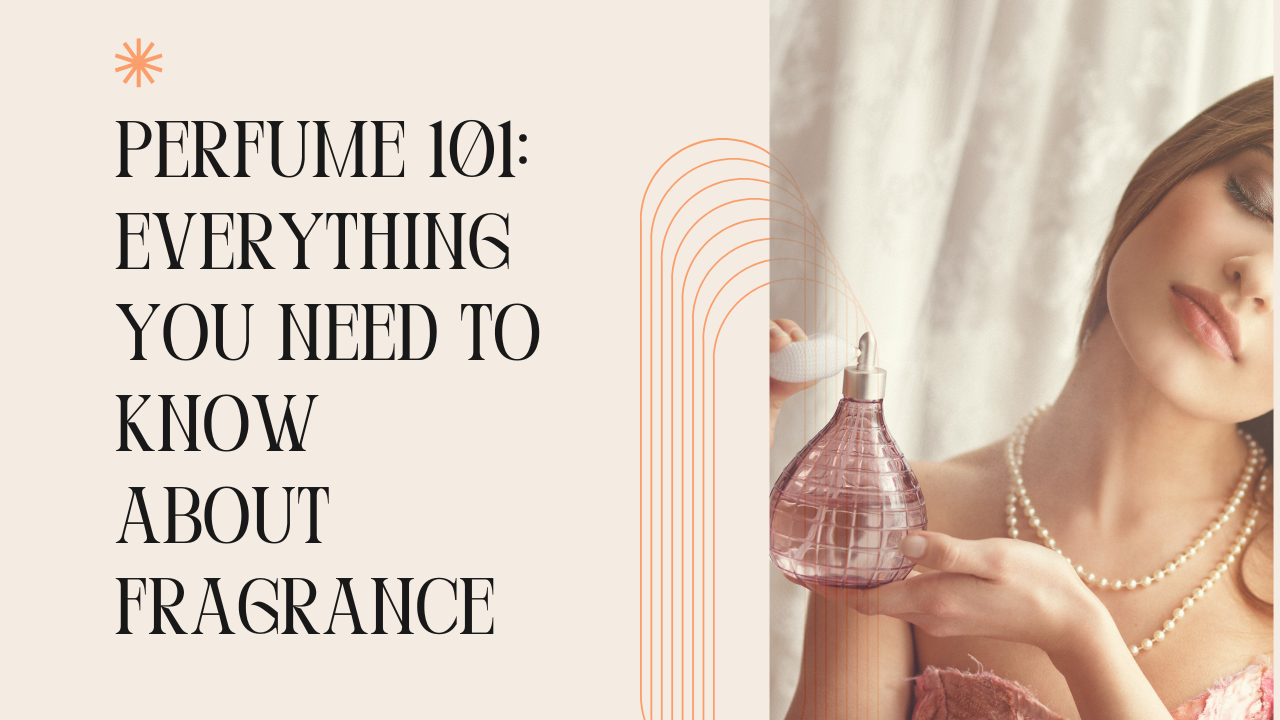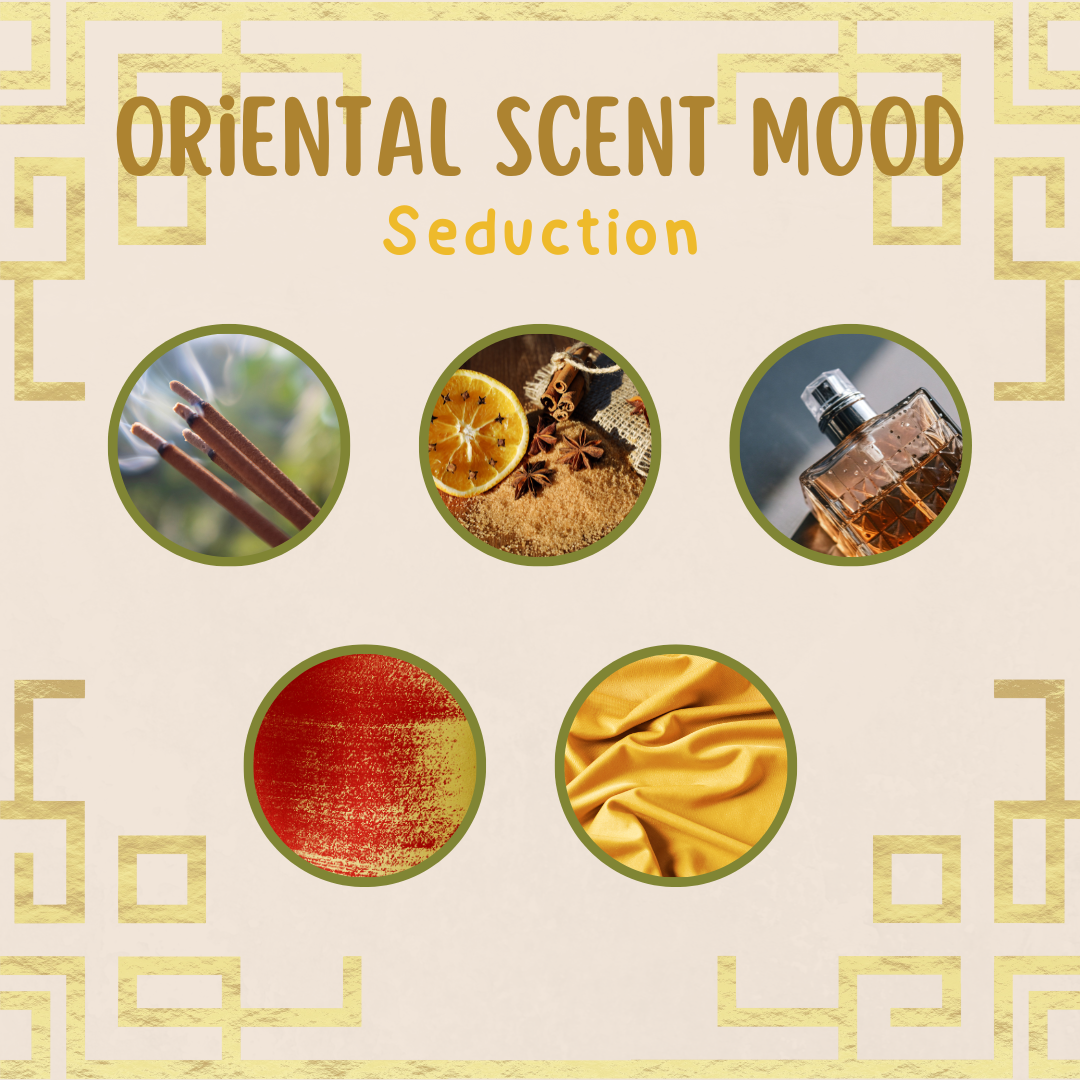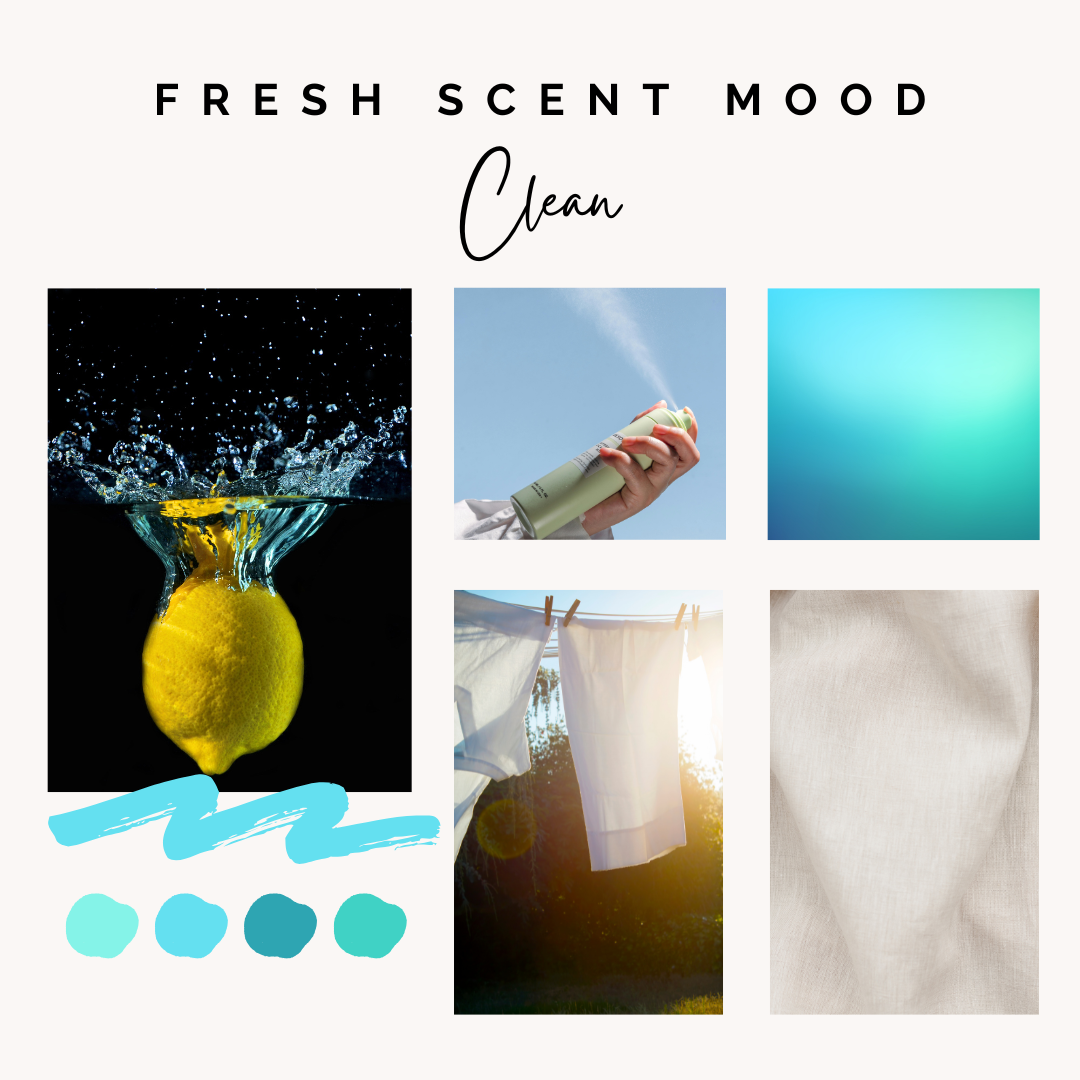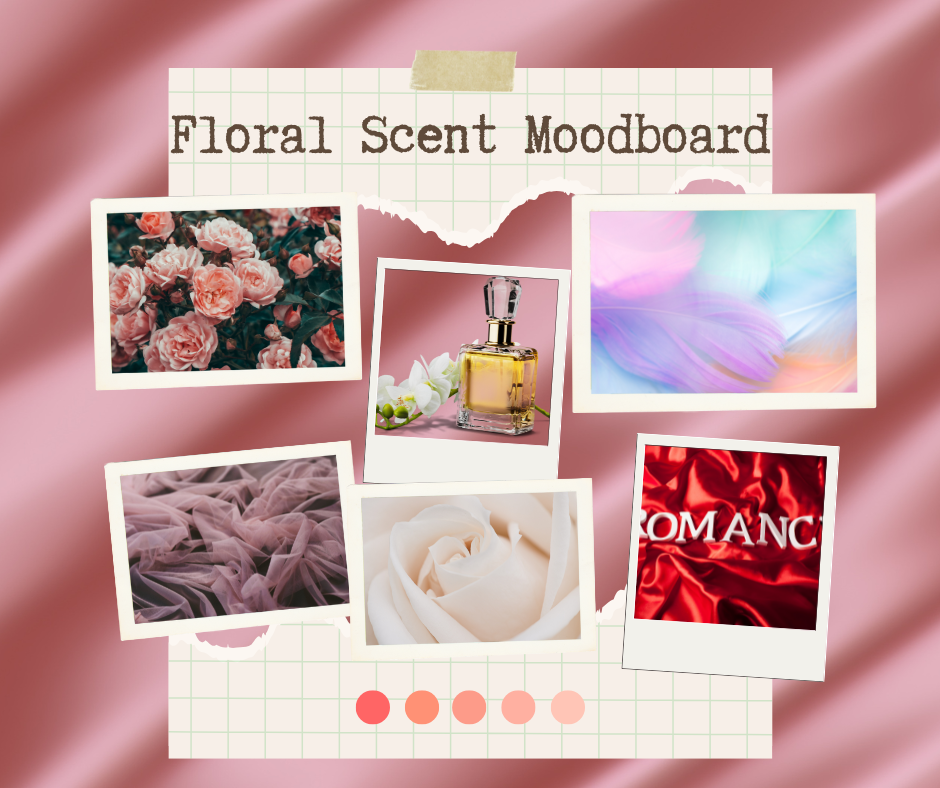Perfume is more than just a luxury product; it’s an art form, a personal signature, and a sensory experience. With a rich history spanning thousands of years, perfume has evolved from ancient aromatic concoctions to modern olfactory masterpieces. This post dives into everything you need to know about perfume—from its creation to the fascinating layers of scents that make it unique.
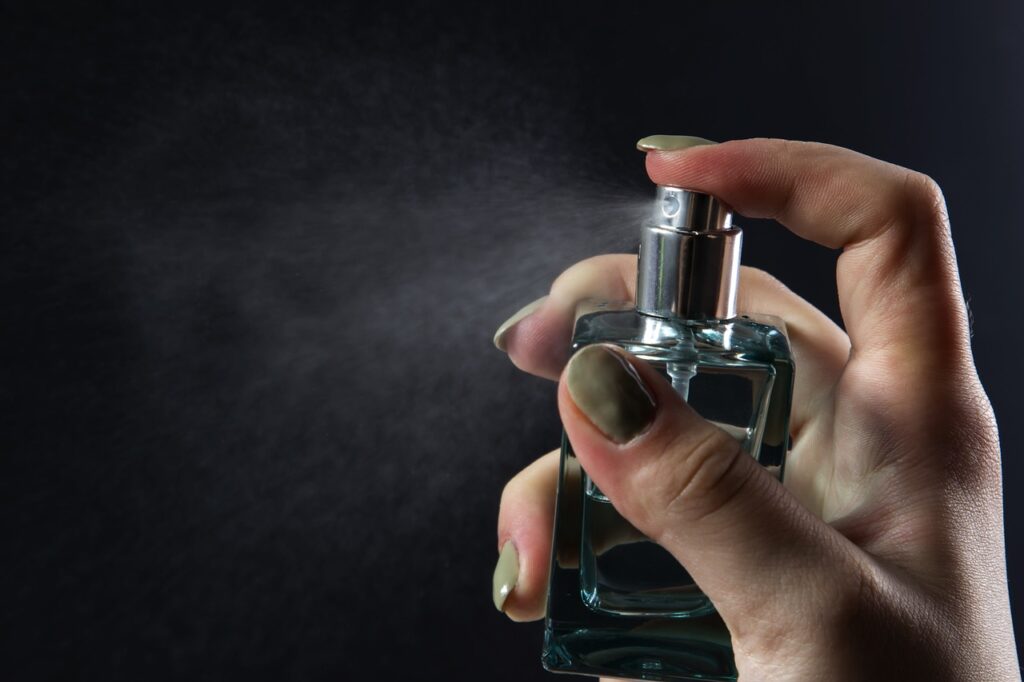
What is Perfume?
Perfume is a mixture of aromatic compounds, essential oils, alcohol, and water designed to produce a pleasing scent. Its purpose can be functional, such as masking body odour, or symbolic, reflecting personality, status, or culture. The word “perfume” originates from the Latin term per fumum, meaning “through smoke,” referencing its early use in religious rituals involving incense. Today, perfume is an essential part of personal grooming, celebrated for its ability to evoke emotions, memories, and moods.
History of Perfume
Origins in Ancient Egypt and Early Civilizations
Perfume has woven itself into human history for over five millennia, evolving from sacred ritual to a deeply personal expression of identity and style. Its origins can be traced back to ancient Egypt around 3000 BCE, where fragrant oils and incense were used in religious ceremonies, burial practices, and to honour the gods. Scents like frankincense, myrrh, and lotus oil were believed to carry spiritual significance and were reserved for royalty and priests. As trade routes expanded, the use of perfume spread to ancient Greece and Rome, where it became a mark of luxury and refinement. Wealthy Romans bathed in scented oils, perfumed their homes, and even infused their clothes with fragrance.
The Islamic Golden Age and the Birth of Modern Distillation
A major turning point came during the Islamic Golden Age (8th to 13th century), when Persian scientist Avicenna pioneered the steam distillation of rose, a method that revolutionised the production of essential oils and remains a foundation of modern perfumery. This innovation not only improved the purity and intensity of floral extracts but also spread through trade and scholarly exchanges, influencing both European and Asian scent-making techniques.
Medieval and Renaissance Perfume Culture in Europe
In the Middle Ages and Renaissance, perfumery gained momentum across Europe, especially in France and Italy. The town of Grasse in southern France became a hub for cultivating aromatic plants like jasmine, rose, and lavender, giving birth to what is still considered the world’s fragrance capital. During the era of plagues, perfume also played a practical role—many believed that pleasant scents could protect against disease. By the late Renaissance, the demand for eau de Cologne and other luxury “waters” had surged among European nobility.
The 19th Century: Synthetics and the New Era of Complexity
The 19th century ushered in a new era with the discovery of synthetic aroma compounds, such as vanillin and coumarin. These breakthroughs allowed perfumers to craft more complex and enduring scents that were not solely dependent on scarce or seasonal botanicals. The introduction of synthetics democratized fragrance, making it more affordable and consistent in quality. Perfume houses began listing ingredients on labels, and scent formulas became proprietary treasures.
The 20th Century: From Chanel No. 5 to Celebrity Fragrances
The 20th century saw fragrance become a true cultural phenomenon. In 1921, Chanel No. 5 broke ground by blending natural and synthetic notes into a signature scent that remains iconic today. During the mid-century, houses like Dior and Givenchy solidified perfume as a form of haute couture accessory. By the 2000s, the rise of celebrity-branded fragrances—often backed by extensive marketing campaigns—further expanded the market and introduced new customers to the world of perfumery.
Contemporary Trends: Niche, Sustainability, and Personal Expression
Today, perfume is more diverse and creative than ever before. Niche fragrance houses challenge convention with bold, genderless compositions, while sustainability and transparency have become key considerations in formulation and packaging. Despite its evolution, perfume remains what it has always been—an intimate and invisible accessory that stirs memory, emotion, and imagination.
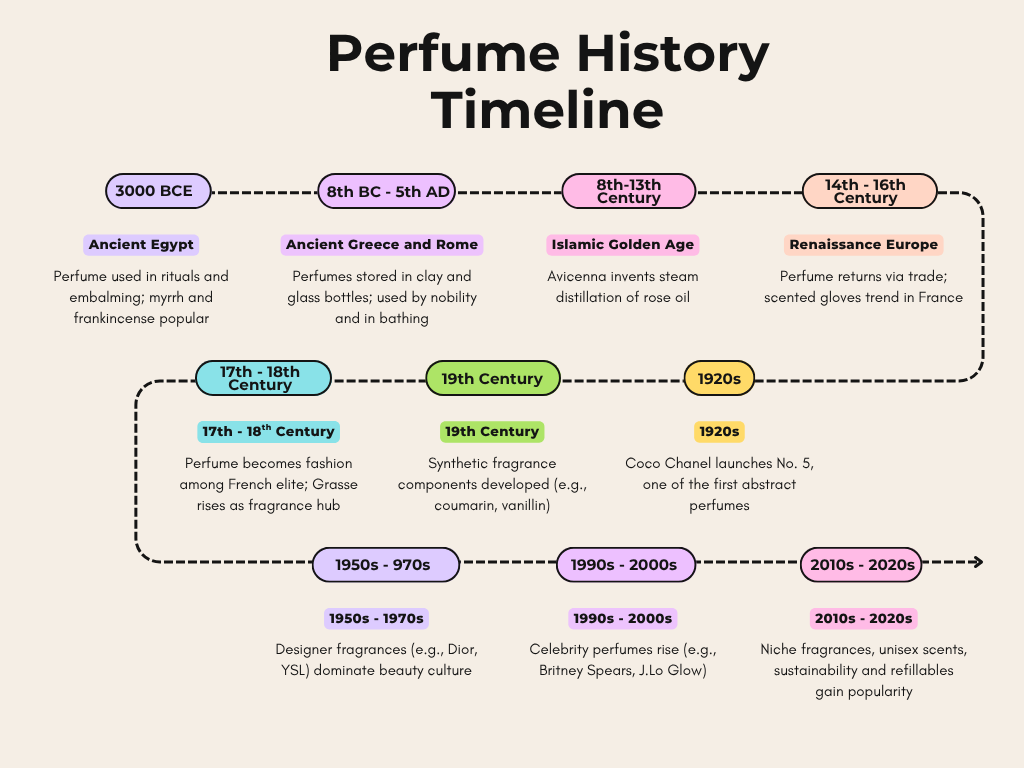
How is Perfume Made?
The creation of perfume is both a science and an art, requiring precision and creativity. The process generally involves the following steps:
Harvesting Ingredients: Natural materials such as flowers, fruits, spices, woods, and resins are collected. Synthetic compounds may also be used to replicate rare or expensive ingredients.
Extraction of Aromatic Compounds: Fragrances are extracted from raw materials using methods such as distillation, solvent extraction, expression, or enfleurage. For example, steam distillation is commonly used to extract essential oils from flowers, while enfleurage is a traditional technique for delicate blossoms.
Blending: Once extracted, these aromatic compounds are blended by perfumers, often referred to as “noses.” This process involves creating a balanced composition, combining top, middle, and base notes for a harmonious scent.
Ageing: The blended mixture is aged for several months to allow the scents to develop and harmonise.
Dilution and Bottling: The perfume concentrate is diluted with alcohol and water to create the final product, then filtered and bottled. The concentration of aromatic compounds determines the perfume’s intensity.
Types of Perfume
Perfumes are classified based on the concentration of aromatic compounds, which influences their longevity and strength:
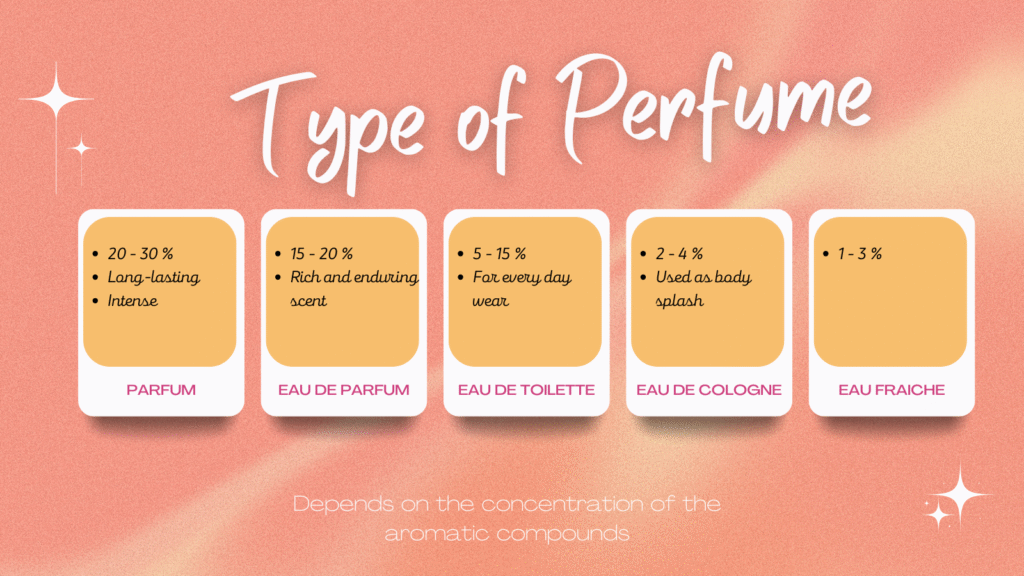
Ingredients in Perfume
The primary ingredients in perfume can be broadly classified into three categories: natural, synthetic, and fixatives.
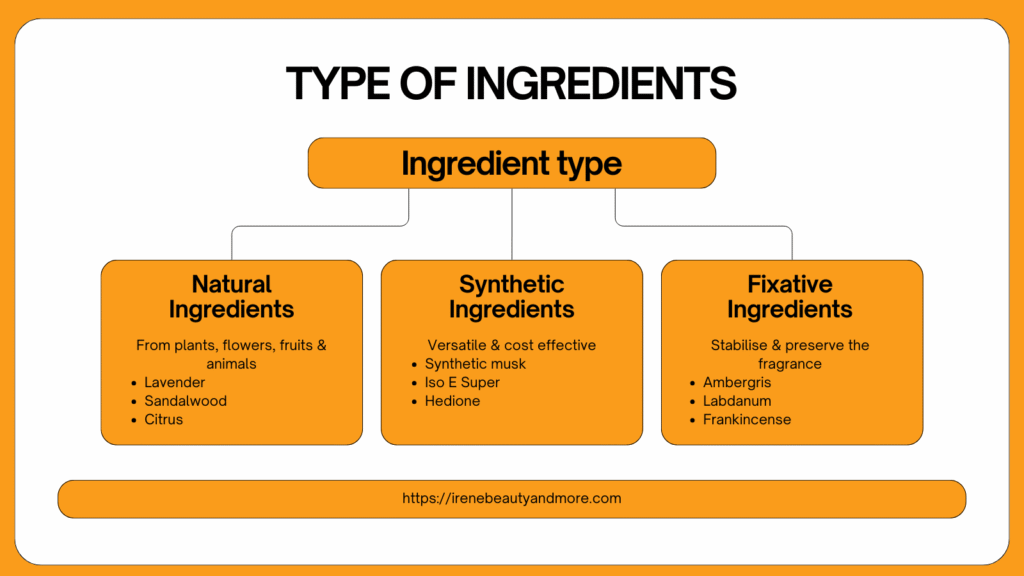
Scent Families in Perfume
Perfume scent families help categorise fragrances into broad categories based on their primary aromas. The following are the most common scent families:
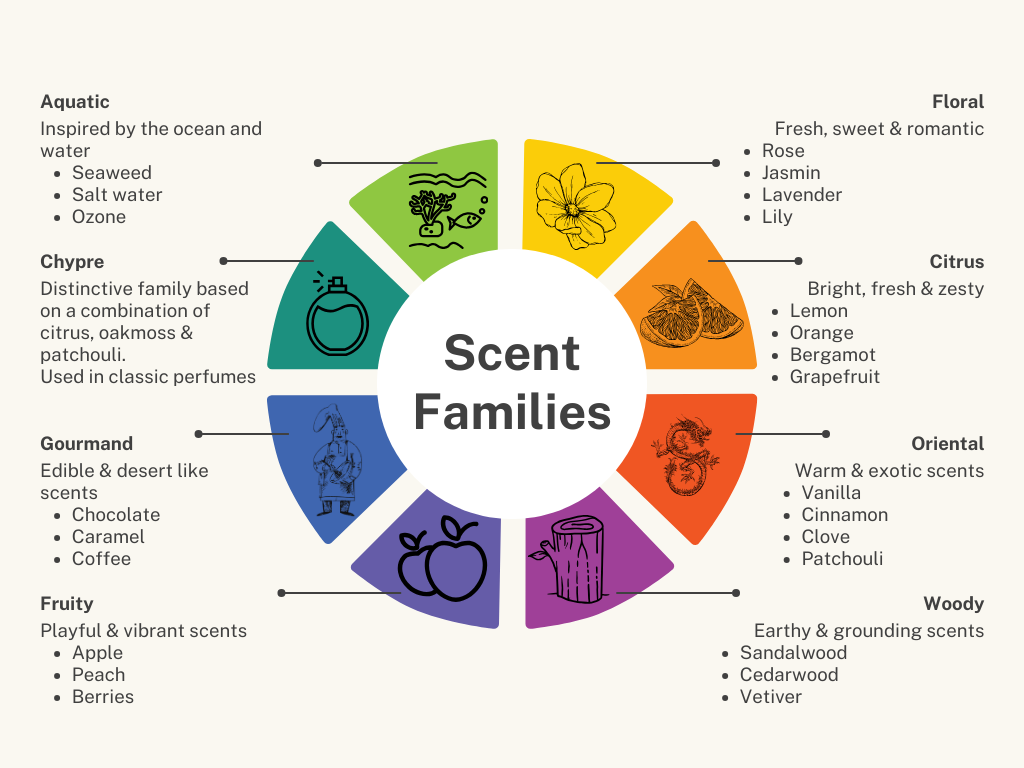
Perfume Notes
Perfume notes play a crucial role in how a fragrance evolves and interacts with your skin. These notes are classified into three layers, each with its own characteristics and lasting power.
1. Top Notes (The First Impression)
Top notes are the first scents you experience upon applying perfume. They are light, fresh, and often volatile, disappearing quickly within the first 10-15 minutes. Top notes are like the introduction to a fragrance, setting the stage for the heart and base notes to come.
Common Ingredients:
| Ingredient type | Example |
|---|---|
| CITRUS | Lemon, lime, orange, bergamot, grapefruit |
| HERBS | Basil, mint, thyme, sage |
| FRUITS | Apple, pear, berries, melon |
| AROMATIC | Lavender, eucalyptus |
Examples:
2. Middle Notes (The Heart of the Fragrance)
Middle notes emerge once the top notes fade. These notes form the core of the fragrance and are often rich, complex, and lasting. They are designed to make up most of the perfume’s body and typically stay around for 1-2 hours.
Common Ingredients:
| Ingredient type | Example |
|---|---|
| FLORALS | Jasmine, rose, geranium, lily-of-the-valley, freesia |
| SPICES | Cinnamon, nutmeg, cardamom, clove |
| GREEN NOTES | Grass, tea, mint, basil |
| FRUITY | Peach, plum, cherry |
Examples:
3. Base Notes (The Foundation)
Base notes are the final scents that appear once the middle notes have settled. These notes provide depth, warmth, and longevity to the fragrance, lingering on the skin for hours, sometimes even days. Base notes are heavier, thicker, and often sweet or earthy.
Common Ingredients:
| Ingredient type | Example |
|---|---|
| WOODS | Sandalwood, cedarwood, vetiver, patchouli |
| RESINS | Amber, frankincense, myrrh, benzoin |
| BALSAMS | Tolu, Peru balsam |
| SWEET NOTES | Vanilla, tonka bean, musk, praline, caramel |
| GOURMAND NOTES | Chocolate, coffee, honey |
Examples:

How Notes Work Together
The beauty of perfume lies in how these notes interact over time. As the top notes evaporate quickly, they give way to the middle notes, which will evolve into the base notes. The base notes are what will linger, making the scent long-lasting and memorable.
How to Choose the Right Perfume
Choosing a perfume is a personal journey influenced by preferences, skin chemistry, and lifestyle. Here are some tips:
Tips for Making Perfume Last Longer
Maximising a perfume’s longevity involves thoughtful application and storage:
Examples
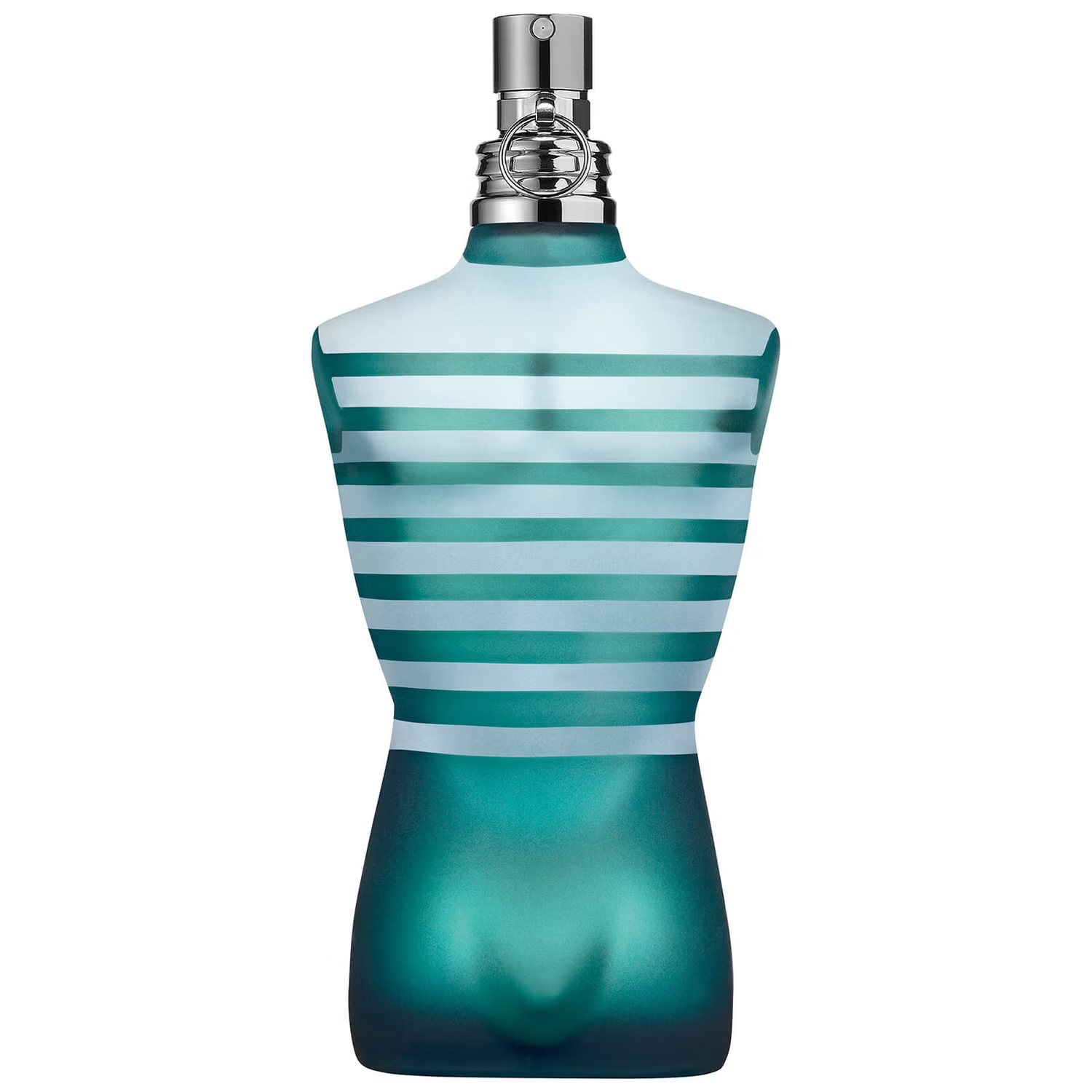
Jean Paul Gaultier Le Male
Top Notes: Mint, lavender, bergamot
Middle Notes: Cinnamon, cumin, orange blossom
Base Notes: Vanilla, sandalwood, tonka bean, amber
Le Male is a sweet, spicy fragrance with a fresh minty top, followed by a warm, spicy heart with cinnamon and orange blossom. The base is sweet and creamy with vanilla and tonka bean, giving it a comforting, masculine appeal.

Chanel No 5
Top Notes: Aldehydes, neroli, ylang-ylang, bergamot
Middle Notes: Jasmine, rose, lily-of-the-valley, iris
Base Notes: Vetiver, sandalwood, vanilla, amber
A timeless classic, Chanel No. 5 has a complex blend of floral notes in the heart, with the aldehydes adding a crisp, powdery freshness. The rich base notes of vetiver, sandalwood, and amber provide depth, making it an elegant and sophisticated fragrance.

Dior J’adore
Top Notes: Ylang-ylang, bergamot, pear
Middle Notes: Jasmine, rose, lily-of-the-valley
Base Notes: Musk, vanilla, cedarwood
J’adore is a rich, floral fragrance with an initial burst of fresh pear and citrus, followed by a heart of jasmine and rose. The base of musk and vanilla creates a sensual, lasting finish that is both elegant and seductive.
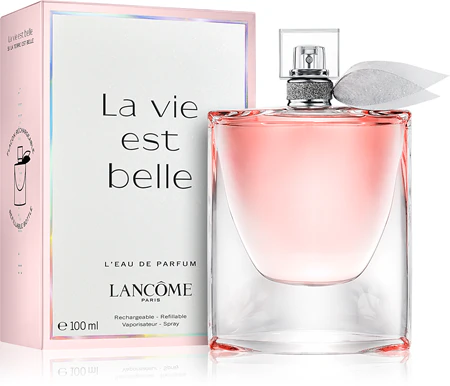
Lancome La Vie Est Belle
Top Notes: Black currant, pear
Middle Notes: Iris, jasmine, orange blossom
Base Notes: Praline, tonka bean, vanilla, patchouli
La Vie Est Belle is a sweet, gourmand fragrance that begins with fresh fruit notes of pear and black currant. The heart reveals a floral mix of iris, jasmine, and orange blossom, while the base offers a warm, comforting blend of praline, vanilla, and patchouli.
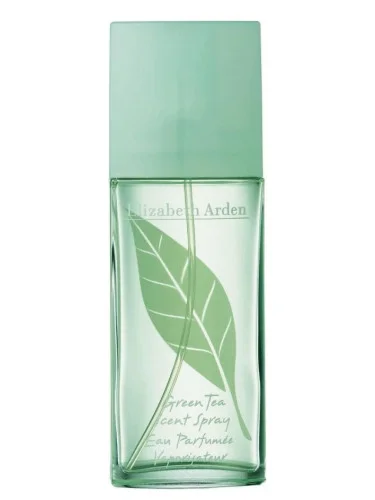
Elizabeth Arden Green Tea
Top Notes: Lemon, orange, rhubarb
Middle Notes: Jasmine, mint, green tea
Base Notes: Musk, oakmoss, amber
Green Tea is a refreshing, citrusy fragrance with a calming green tea heart. The base of musk and amber provides a soft, woody undertone that balances the bright top notes.
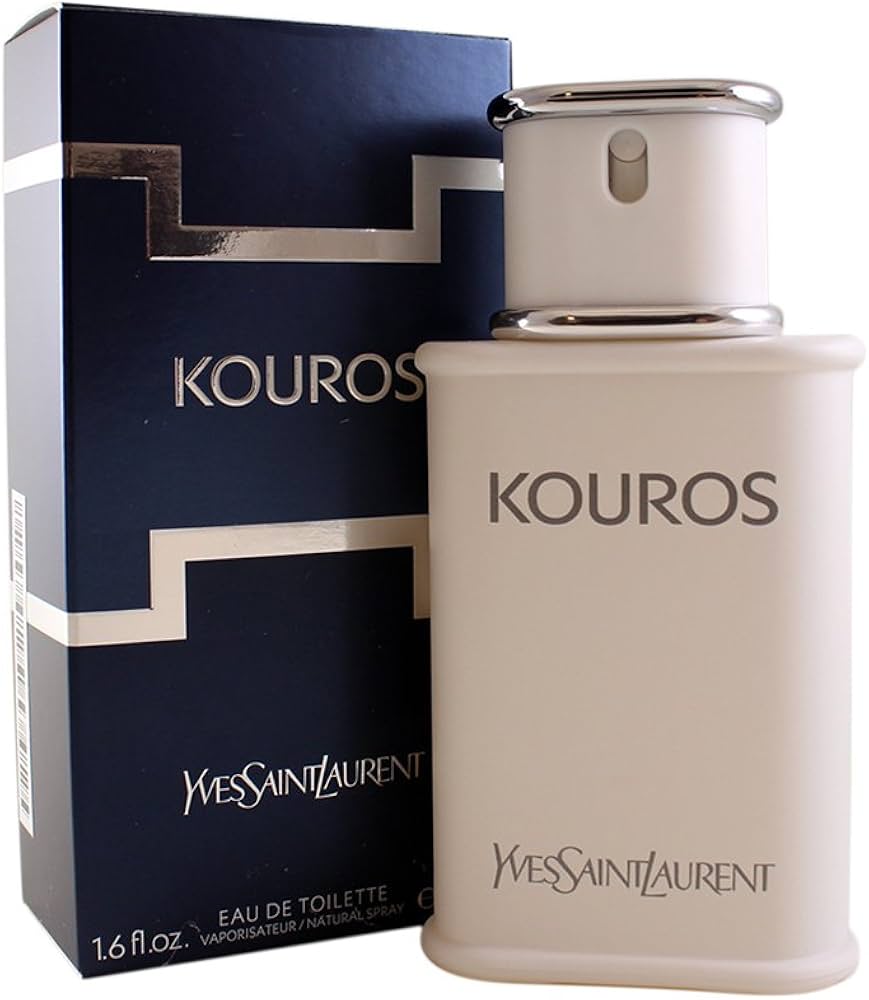
Yves Saint Laurent Kouros
Top Notes: Aldehydes, Bergamot, Artemisia, Coriander
Middle Notes: Orris, Jasmine, Cinnamon
Base Notes: Amber, Leather, Musk, Civet
Released in 1981, Kouros is a bold and powerful fragrance, embodying masculinity with a sharp opening and deep, warm base notes. The aldehydic start gives it a clean, soapy scent, while the spice and woodiness offer a complex, mature profile. The leathery finish is iconic and distinctly vintage.
Sources: FragranceX | Basenotes
What is Fragantica?
Fragrantica is a popular online resource and community dedicated to all things fragrance. It offers detailed information on perfumes, including reviews, notes, ratings, and perfume composition. Users can explore various perfume types, search by ingredients, discover new releases, and find recommendations based on preferences or scent families. Fragrantica also features articles, news, and discussions where fragrance enthusiasts can engage and share their experiences.
You can visit Fragrantica for detailed reviews and updates on your favourite perfumes: Fragrantica.
Conclusion
Perfume is a fascinating blend of artistry, chemistry, and emotion. Understanding its components, types, and structure can help you appreciate the craftsmanship behind every bottle. Whether you prefer light florals, deep woody scents, or vibrant fruity aromas, there’s a perfect fragrance for everyone. Let your perfume reflect your individuality, making it your personal signature in a sensory world.
Bear in mind that some of the links in this post are affiliate links and if you go through them to make a purchase I will earn a commission. Keep in mind that I link these companies and their products because of their quality and not because of the commission I receive from your purchases. The decision is yours, and whether or not you decide to buy something is completely up to you.
